Victorian wealth and improvement
Nottingham is a city that many know for shopping and the arts, but seldom venture outside its inner core. In this walk, Nicholas Rudd-Jones takes you through several of Nottingham’s delightful green spaces
WALK DATA
- Distance: 14.4 km (9 miles); shorter route is 12.3Kms (7.7 miles)
- Typical time: 4 hours (3.5 hrs)
- Height Gain: 30 metres
- Start and finish: Nottingham Cathedral (NG1 5AE)
- Terrain: very straightforward; sturdy footwear needed; some steep ups and downs around The Park
BEST FOR
‘Green Spaces’
| Parks, gardens, squares, cemeteries | University Park, Wollaton Park, The General Cemetery, The Arboretum |
| Rivers, canals, lakes | Nottingham Canal, River Leen, Lakeside |
| Stunning cityscape | St Anne’s Hill, The Ropewalk, the garden of Hart’s Hotel |
| ‘Architectural Inspiration’ | |
| Ancient Buildings & Structures (pre-1740) | Wollaton Hall, Nottingham Caves (not on route) |
| Georgian (1714-1836) | The Roman Catholic Cathedral |
| Victorian & Edwardian (1837-1918) | The Park Estate (started in the 1810s) |
| Industrial Heritage | The Lace Market (not on route) |
| Modern (post-1918) | Nottingham Playhouse, Nottingham Contemporary, Trent Building (University) |
| ‘Fun stuff’ | |
| Great ‘Pit Stops’ | Pavilion Café, Lakeside; Delilahs Deli & Café |
| Quirky Shopping | Bridlesmith Gate, Hockley, Flying Horse Arcade |
| Places to visit | Nottingham Castle, Natural History Museum, Nottingham Contemporary |
| Popular annual festivals & events | Arboretum Festival (early May), Food & Drink Festival (May), The Park Open Gardens Trail (June), Riverside Festival (late July) |
City population: 310,837 (2011 census)
Urban population: 729,977 (2011 census)
Ranking: 14th largest city in the UK
Date of origin: 600AD
‘Type’ of city: ‘Light Industrial’ manufacturing city
City walkability (www.walkscore.com): 98/100 Walker’s Paradise
City status: City status was awarded as part of the Diamond Jubilee celebrations of Queen Victoria in 1897
Some famous inhabitants: Jesse Boot (Boots the Chemist), Sir Paul Smith (fashion designer), DH Lawrence (author), Robert Harris (novelist), Ken Clarke (MP), Robin Hood (bandit), Stuart Broad (cricketer), Torvill & Dean (ice skaters)
Notable city architects/planners: Watson Fothergill – designed over 100 buildings in Nottingham, in Gothic revival style, including villas at 5 & 7 Lenton Rd in The Park (on the route)
Films/TV series shot here: Saturday Night and Sunday Morning (1960), The Loneliness of the Long-Distance Runner (1962), Harry Potter & The Order of the Phoenix (2007), The Dark Knight Rises (2011)
THE CONTEXT
Nottingham is a mediaeval city that became wealthy during the nineteenth century through lace manufacture. The quarter called ‘The Lace Market’, which is today full of bars, restaurants and design companies is where trade was carried out and garments created.
Nottingham had been widely known as a garden town in the eighteenth century but had grown in upon itself from the 1780s onwards as trade expanded, with very poor quality housing and sanitation.
The landscape historian WG Hoskins describes the damaging effect of late enclosure on Nottingham; “The town could not grow outwards (due to resistance from vested interests). So every garden, every orchard, every foot of open space within the old confines, was doled out piecemeal at exorbitant prices for building. In some parts, there were 800 people living in a single acre.”
The much overdue Enclosure Act of 1845 finally released the pressure, allowing for expansion outside the city walls; and in the next forty years, the population tripled to 150,000.
The good news was that at this time extensive provision was also made for green spaces. 120 acres were allotted to the corporation in trust for the people of Nottingham for public baths and walks, cricket and football grounds, and a cemetery. This was in line with the provisions of the Act, which reflected a growing recognition nationally of the health and recreational benefits of creating `green lungs’ in the industrial towns. Parliament had with great foresight adopted a standing order in 1839 that all future enclosure bills should make provision for open spaces for recreation.
As a result, the Forest (just to the north of our walk) was largely preserved, the Arboretum was opened in 1852 and a number of ‘walks’ were created which effectively produced a ‘green collar’ around the town. A visiting journalist wrote of how the “recreation walks – which are, in truth, almost a continuous avenue of trees – completely encircle the town, and afford a promenade of ten miles in extent… a proportion of open space that is still envied by other cities”. These open spaces are still in existence today – Elm Avenue, Corporation Oaks, Robin Hood Chase, Queen’s Drive and the Forest – several of which our walk takes us along.
As the landscape and the living conditions of the city improved, so there was also a drive for better education. A university was first established in 1875 with the help of an anonymous benefactor; and then the generosity of Sir Jesse Boot allowed it to move to its expanded University Park site in the late 1920s. This success is reflected today in a total student population of over 60,000 across two universities, which are consistently highly rated both by students and employers.
THE WALK
Our walk started at St Barnabas Roman Catholic Cathedral, first consecrated in 1844, fifteen years after the Catholic Relief Act ended most restrictions on Catholicism in the United Kingdom. The building was designed in the Early English Plain Gothic style by the leading Victorian ecclesiastical architect Augustus Pugin, who also designed the interior of The Houses of Parliament.
Next we passed the Nottingham Playhouse, built in the modernist style by Peter Moro who had worked on the interior design of the Royal Festival Hall in London. Being in such sharp architectural contrast to the cathedral and the surrounding red-brick villas, it caused quite a buzz of controversy when it was first built in 1963. During the 1980s, when the concrete interiors were out of fashion, the Playhouse was subject to ‘refurbishment’ that sought to hide its character. But in 2004, it was sympathetically restored and refurbished with a grant from the Heritage Lottery Fund.
But the first thing you will notice today is the Sky Mirror public sculpture by artist Anish Kapoor just in front of the Playhouse. It is a six-metre-wide concave dish of polished stainless steel, weighing ten tonnes and angled up towards the sky. Its surface reflects the ever-changing environment. It too was the subject of much controversy when it was installed, as the mirror could focus light, in the same way as a magnifying glass, down to a particular point. As the consultant astronomer to the project said: “You need to stop the sun from falling on it in the first place. If you don’t there’s a potential danger. Any pigeon which flies through the beam could be instantly barbequed.” The solution was the erection of a sunscreen on the Playhouse roof – and to date, no barbequed pigeons have been reported.
Meanwhile, it has become very popular with the public, being voted the city’s favourite landmark. Its structure appears to defy gravity, while its highly polished surface reflects a city turned upside down.
From the top of Park Row, you get what for me is very much one of those ‘gosh, I would really love to live here’ moments. Personal admission: I love complicated Victorian houses, more than classic and elegant Georgian houses for some strange, inexplicable reason. Here there are Grand Victorian mansions as far as the eye can see, carefully laid out around avenues and circuses, with tennis courts; the original gas lighting, gates to the estate and privately maintained roads. Admittedly you have to pay a ‘park rate’ as well as council tax, but I’m sure it’s worth it for this large slice of domestic bliss, right alongside a bustling city but also quite separate from it. And I notice they didn’t let the Google camera van in – there is no Google Street view for the Park Estate, so armchair rubbernecking is thwarted.
The Park is one of the most complete Victorian estates I have seen in the country (the only other comparable one I can think of is North Oxford) and was built on a carefully planned basis from the 1820s onwards. It used to be the deer park of Nottingham Castle, and its development was highly controversial, as the people of Nottingham felt that the land was for public use. It became home to many eminent Nottingham residents, including Jesse Boot of Boots fame.
Our walk took us across Newcastle Circus, where the Residents’ Association organises boules games every summer, and the Circus positively purrs with gentility and agreeableness. This is a lovely spot to stop and relax for a few moments, although it is almost eerily quiet and devoid of people. Where are they all? Maybe it’s the absence of shops or pubs that give it this feeling…
After hanging around on the benches in the Circus for a while, we headed west and south, then down a small steep passage out of the Park, at the end of which we suddenly arrived back in the ‘everyday’ world, in the shape of a busy main road. Thankfully you don’t have to stay on this for long. We crossed over the Castle Bridge and then onto the canal path heading west. On the left is the bustling Nottingham Marina, now given over to leisure boats and a strong narrow boat community (a strong aroma of woodsmoke permeated the air, especially noticeable on the cold day we ambled through) but originally an unloading area for building materials, coal and agricultural tools.
A bit further on and another waterway crosses under the canal – this is The River Leen, a 15-mile tributary of the Trent, culverted in several places as it passes south-east through the city; on another day it would make for a good exploration in its own right. You will pass by it again later in the walk.
To get to the university campus area, we then crossed over Chain Lane Bridge and cut up through a residential street to reach the main road.
Nottingham University underwent significant expansion in the 1920s when it moved from the centre of Nottingham to this site. The new campus, called University Park, was completed in 1928 and financed by an endowment fund, public contributions and the generosity of Sir Jesse Boot (later Lord Trent) who presented 35 acres to the City of Nottingham in 1921. Boot and his fellow benefactors sought to establish an ‘elite seat of learning’ committed to widening participation. Very helpfully to us lovers of green spaces, Boot stipulated that whilst part of the site should be devoted to the University College, the rest should provide a place of recreation for the residents of the city; and by the end of the decade the landscaping of the lake and public park adjoining University Boulevard was completed.
The novelist D. H. Lawrence, who was born and grew up near to Nottingham, commented on the endowment and the architecture in a rather dismissive way:
In Nottingham, that dismal town where I went to school and college,
they’ve built a new university for a new dispensation of knowledge.
Built it most grand and cakeily out of the noble loot
derived from shrewd cash-chemistry by good Sir Jesse Boot.
I don’t think he would have been too chuffed to know that the arts centre (left in the picture) is named after him; it’s now known as the DH Lawrence Pavilion.
Finally, there’s a bit of a hill to climb as we headed into Wollaton Park, Nottingham’s biggest park, and the very fine Wollaton Hall, built in the late 16th century. It’s now the Natural History Museum and has a good café which makes a neat half-way breakpoint.
We then walked back into town, through a residential area of characteristic 1940s properties with brick-faced porches; and then back down the side of the River Leen. Eventually, the route took us back into The Park briefly before coming out onto the main road. At this point, you need to establish how much energy you have left. If tired, you can finish up now with a lovely cutback along Newcastle Drive, which gives you a final grandstand view of The Park.
But we hope that you can persuade your walking companion to go on and visit the green spaces which relate directly to the Nottingham Enclosure Act of 1845 – a visionary project to create a green network around the growing city, to provide green spaces for relaxation, contemplation, learning, exercise and clean air.
The Nottingham General Cemetery (7.4 hectares, 18.4 acres) dates from the 1830s, a time when many churchyards were becoming overcrowded, especially in towns and cities. It was a vital step to take the pressure off graveyards which were becoming over full. Incredibly, by 1923 over 150,000 people had been buried in this cemetery, and it was closed to new burials due to health concerns. After many decades of neglect it has steadily been brought back into the shape it is in today; a very calming green space through which to walk, with lots of wildlife.
Nottingham Arboretum (6.3 hectares, 15.7 acres), almost a continuation of the cemetery, was designed and laid out in 1850 by Samuel Curtis, a botanist and horticultural publicist who had previously been involved with the layout of Victoria Park in the East End of London in 1842. It was the first public park opened in Nottingham. Today it is a delightful and well-maintained space and is often used for open-air events.
The main aim of the design for the Arboretum was to take advantage of the landscape setting whilst providing an interlinking network of walkways and socialising areas. As a result, over 1,000 specimen trees and shrubs were planted along with winding paths and sweeping lawns. The plantings were laid out in what is known as ‘The Natural Order’ to provide an educational link to nature through botanical interpretation. Today, several of the mature trees and shrubs growing here date back to the original collection, such as the Lime Trees which were planted as nursery trees.
On the right on the rise is the pagoda; around it, four guns from Sebastopol and piles of cannonballs were placed. The cannonballs were subsequently confiscated, as children enjoyed rolling them down the slopes, but the park-keepers unsurprisingly got rather bored of having to retrieve them.
At the end of the main section of the park there is a tunnel which leads to a narrower strip of green, called Arboretum Approach, which in turn leads to a road and then, on the other side is the pleasant, shady walk of Elm Avenue, leading to Corporation Oaks and St Anne’s Hill. From the latter point, we gained splendid views of the City beneath us.
In the words of a nineteenth-century commentator: “The wise policy of the Corporation in providing these stately avenues of “Elms” and “Oaks” in the midst of the crowded city is self-evident.” And so it is; green spaces amidst built-up areas. One piece of foresightedness 170 years ago, still being enjoyed every day.
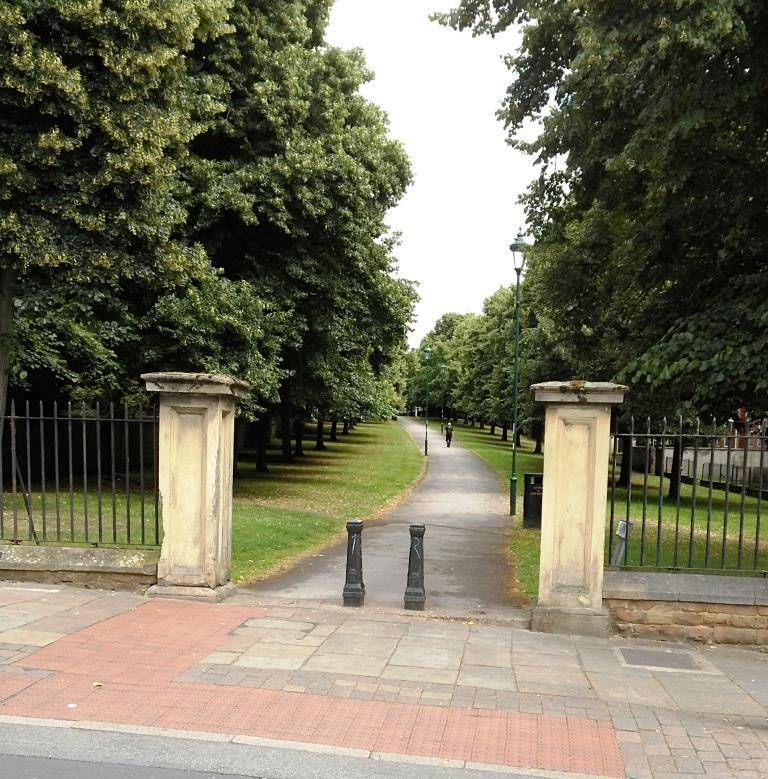
From here we tracked back to the Catholic cathedral and the start of the walk – a pretty satisfyingly high percentage of green space on this walk
THE ROUTE
- Set out from the Playhouse Square on Wellington Circus, heading SW down Oxford St; then left along Ropewalk and right into Park Row, at the end of which you will come to a flight of steps
- Take these steps down into The Park, then a left into Park Valley, right into Lenton Rd, followed by a half right into Park Drive, which will take you to Newcastle Circus
- Cross the Circus into Maxtoke Rd, left into Hardwick Rd, left back on to Lenton Rd, and almost immediately you will see a passage heading south out of the park
- Take this passage (Hermitage Walk) down to the main road (Castle Boulevard), then cross and turn right; cross over at the next bridge (Castle Bridge), take a left as soon after the bridge as you can and swing back onto the canal path and under the bridge you have just crossed
- Plain sailing for a bit, as you follow the canal path, with the marina immediately on your left. Under a railway, a road, the River Leen, a big road, another railway and then it will be time to turn right across a footbridge, called Chain Lane Bridge
- Once over the footbridge, go up Chain Lane then turn right along Gibbons St, go under the railway line again
- Turn left into Claude St. At the end, cross directly onto a footpath/cycle route, and this will take you up to Jesse Boot Boulevard
- Turn right here, cross the A6005 (University Boulevard) to the Lakeside Arts Centre
- Then bear SW along the south side of the lake, crossing by the little island to the north side
- Turn left and follow the lake on the north side to its end
- Then turn right, walking between two lodges into Beeston Lane and heading north
- Where the lane swings to the right, follow a footpath N with metal railings on its right
- Cross the main road and enter Wollaton Park via the gatehouse. Head W towards the lake
- As you approach the lake, turn N up the avenue to Wollaton Hall
- Just before crossing the ‘hah hah’ wall into the Hall, bear right, skirting the ditch until you reach the Lime Tree Avenue (alternatively, skirt round to the left of the Hall if you want to visit the museum)
- Then head east along Lime Tree Avenue to the eastern exit
- Turn left and after a few yards, cross the main road, head east along Charnock Avenue, which swings round to join the A6200
- Cross over and take Hill Side, which runs alongside the River Leen
- Turn left at Leen Gate and cross the River Leen again; at the end of Leen Gate turn left into Gregory St
- Then take the 2nd right into Church St, which you follow to its end (crossing over the railways and then Lenton Boulevard in the process); at which point it becomes Park St, and you should head north
- Look out for a pedestrian area on your right that leads into Harrowby Rd, and then take this road east, to its end
- Turn left into Harlaxton Drive; shortly on your right you will see a passageway going up the hill which takes you to Pelham Crescent; follow this to its end, then turn into North Rd
- Exit The Park by the North Rd gates and head east along the Derby Rd until you reach the complex road system. On the other side of it, you will see the very distinctive blue building which marks the entrance to the cemetery (Shorter loop, marked in brown: If you have had enough at this stage, bear right down Newcastle Terrace just before the police station; after a few yards, you will see a walkway to the left that takes you parallel with the Ropeway, which it shortly re-joins; from here you will very shortly reach the start point again)
- If you are continuing, enter the cemetery under the clocktower and proceed east to the exit in Waverley St; turn left up the hill and you will soon see the Arboretum entrance on your right
- Enter the Arboretum and proceed in a clockwise direction (Extra loop, marked in brown, about a mile altogether. At the far end of the park, a foot tunnel goes under Addison St; follow this charming path until it meets Mansfield Rd, and then cross over and (slightly to the left) you will see Elm Avenue, which leads up to Corporation Oaks, from where you get a good view of the city; then retrace your steps)
- Exit the Arboretum, head down Waverley St, and then shortly take a right into Clarendon St; at the end of which, cross over into Vernon St and you will soon be back at the cathedral.
A detailed Ordnance Survey map of the walk can also be found at www.walkingworld.com, Walk No. 7457
PIT STOPS
Pavilion Café, Lakeside, University of Nottingham. Great spot with lots of choices, half-way round.

Wollaton House Café makes a good half-way break for the walk and a chance to look round the house and museum.
Harts Hotel and Restaurant, Standard Hill, Nottingham NG1 6GN (Tel: 0115 988 1900, www.hartsnottingham.co.uk). Cocktails in the bar perhaps to celebrate a walk successfully completed?! And superb views over the park from the terrace garden.
Ye Old Trip to Jerusalem Inn (www.triptojerusalem.com ) Claims to be England’s oldest pub, dating back to 1189AD. Just below the castle. Worth a visit if you’re feeling touristy.
Delilah’s Deli & Café, 12 Victoria St (www.delilahfinefoods.co.uk). We loved this place in the heart of the city, combining as it does a traditional delicatessen with a tapas style food bar & relaxed café-style seating.
QUIRKY SHOPPING
Bridlesmith Gate A haven for chic boutiques and designer labels, including the original flagship Paul Smith store
Hockley – students, vintage, independent. Nice area for cafés/drinks/meals. Recommended shops in Hockley are Ice Nine alternative jewellery, Cow retro fashions, White Rose, Wild Clothing and Montana local independent fashions.
Flying Horse Walk (www.trch.co.uk) – small arcade with Vivienne Westwood, Whitewall Gallery, Atomic, Inspired.
PLACES TO VISIT
Nottingham Castle Totally destroyed after the Civil War, the medieval castle was replaced by a magnificent ducal mansion in 1674. Then in 1875, it was converted into the first municipal museum and art gallery outside London, which is still its use today.
Nottingham Caves Beneath the Castle there is a labyrinth of manmade caves. Courageous kids will love them, and there’s lots of interesting history to explore.
Opened in 2009 to huge architectural acclaim, The Nottingham Contemporary is one of the largest contemporary art centres in the UK. It has regular exhibitions and very much merits a visit.
Lakeside Arts Centre is the University of Nottingham’s public arts centre and museum presenting an eclectic programme of music, dance, theatre, visual art and family events all year round.
Natural History Museum at Wollaton Hall. The collection contains over 750,000 specimens of geology, botany and zoology.
DISCOVER MORE
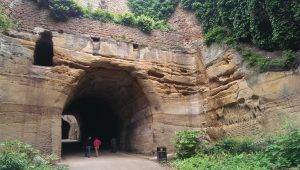 Explore: The Park Tunnel. You might well want to start the walk this way. It was built in 1855 to allow horse drawn carriages access to The Park Estate from Derby Road. There’s an interesting video of it too.
Explore: The Park Tunnel. You might well want to start the walk this way. It was built in 1855 to allow horse drawn carriages access to The Park Estate from Derby Road. There’s an interesting video of it too.

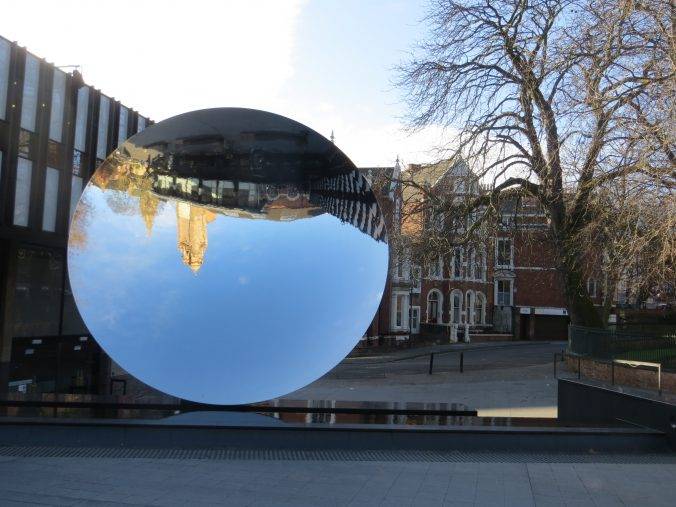
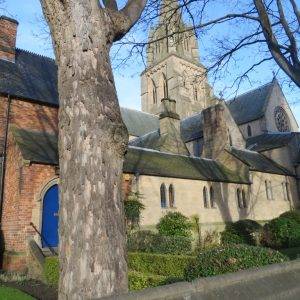
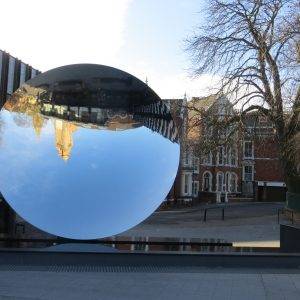
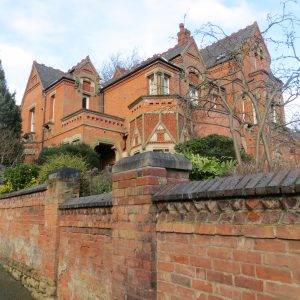
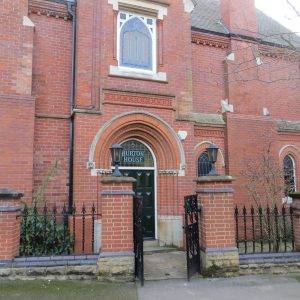
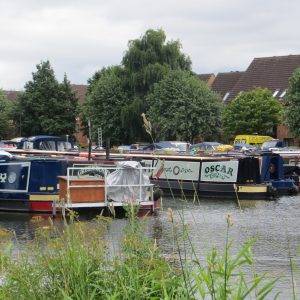
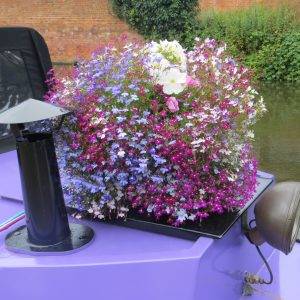
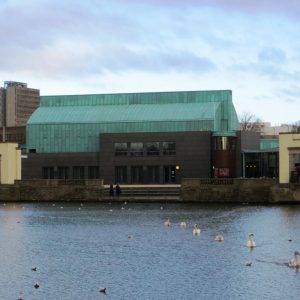
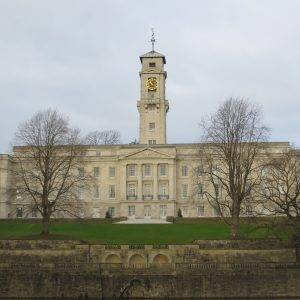
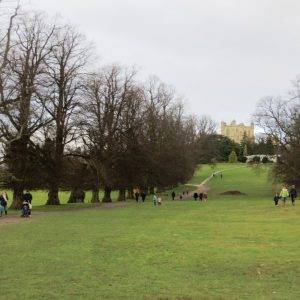
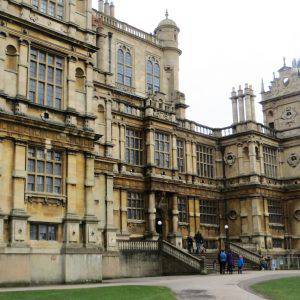
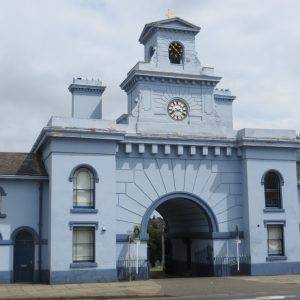
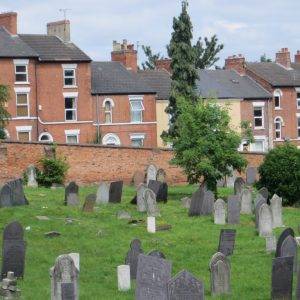
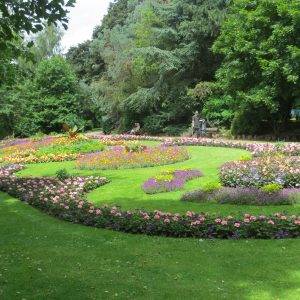
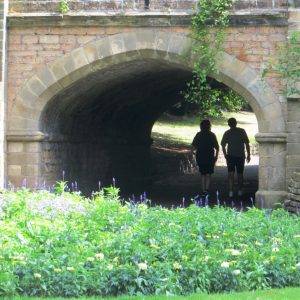
5th February 2017 at 7:47 pm
This is a fantastic page! I organise an urban walking group in Nottingham and you’ve given me many more ideas here for places to include in our walks!
The Park Tunnel has to be one of the most impressive architectural features, you can go down there, circle round to the Park Steps which are really steep, and then walk through Royal Standard place.
Short Steps is also really fun to walk up, as well as the steps at the side of the Nottingham Contemporary.
Please keep sharing any other good places for walks around the Nottingham area.
6th February 2017 at 7:45 am
James,
I really appreciate your feedback – and am so looking forward to trying out the Tunnel, I didn’t know about it!! I live in Stamford, so not too far to come.
Kind regards
Nick
22nd April 2019 at 11:33 am
Thank you for a lovely set of described walks. I represent the Friends of the Forest who have put out a guide to the Inclosure Walk, which you have encouraged your visitors to pursue. It contains information, historical and present, and a map. I hope people can add it to you work in seeking pleasure in walking round the city. June Perry.